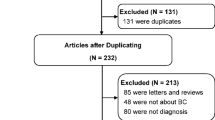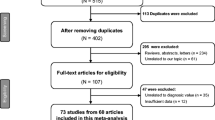Abstract
Serum microRNA-21 (miR-21) expression has been shown to be significantly up-regulated in breast cancer, which implies that it could be a biomarker to discriminate breast cancer patients from healthy controls. We therefore performed this meta-analysis to assess the diagnostic value of miR-21 for breast cancer. Relevant articles were collected from PubMed, Scopus, Embase, the Cochrane Library, BioMed Central, ISI Web of Knowledge, China National Knowledge Infrastructure, Wan Fang Data and Technology of Chongqing databases, from inception to June 10, 2014 by two independent researchers. Diagnostic capacity of miR-21 for breast cancer was assessed using pooled sensitivity and specificity, diagnostic odds ratio (DOR), area under the summary receiver operating characteristic (AUC) and Fagan’s nomogram. Meta-Disc software and Stata SE 12.0 were used to investigate the source of heterogeneity and to perform the meta-analysis. We used six studies with a total of 438 patients and 228 healthy controls in this meta-analysis. The pooled sensitivity, specificity and DOR were 0.79 [95 % confidence interval (CI) 0.66–0.87], 0.85 (95 % CI 0.75–0.91) and 19.46 (95 % CI 8.74–43.30), respectively; positive and negative likelihood ratios were 5 and 0.25, and AUC was 0.89 (95 % CI 0.86–0.91). In addition, heterogeneity was clearly apparent but was not caused by the threshold effect. This meta-analysis suggests that miR-21 is a potential biomarker for early diagnosis of breast cancer with high sensitivity and specificity, and its clinical application warrants further investigation.





Similar content being viewed by others
References
DeSantis CE, Lin CC, Mariotto AB, et al. Cancer treatment and survivorship statistics, 2014. CA Cancer J Clin. 2014;64(4):252–71. doi:10.3322/caac.21235.
Danny RY, Susanna MC, Cheng HY, Baade PD, et al. Incidence and mortality of female breast cancer in the Asia-Pacific region. Cancer Biol Med. 2014;11:101–15. doi:10.7497/j.issn.2095-3941.2014.02.005.
James SL, Water HG, Noel JW. Viruses and human breast cancer. Future microbiol. 2006;1(1):33–51.
Ismail J, John RB. Novel approaches to the diagnosis and treatment of breast cancer. Future Oncol. 2014;10(4):515–8.
Heywang-Kobrunner SH, Hacher A, Sedlacek S. Advantages and disadvantages of mammography screening. Breast Care. 2011;6:199–207. doi:10.1159/000329005.
Euler-Chelpin MV, Louise MR, Brian LT, et al. Risk of breast cancer after false-positive test results in screening mammography. J Natl Cancer Inst. 2012;104(9):682–9. doi:10.1093/jnci/djs176.
Mahendar P, Nagulu M, Uday KV, et al. evaluation of tumor markers in southern Indian breast cancer patients. Asian Pac J Cancer Prev. 2010;11:157–9.
Fiorella G, Patrizia F, Sandro C, et al. A re-evaluation of carcinoembryonic antigen (CEA) as a serum marker for breast cancer : a prospective longitudinal study. Clin Cancer Res. 2001;7:2357–62.
Nicolini A, Colombini C, Luciani L, et al. Evaluation of serum CA15-3 determination with CEA and TPA in the post-operative follow-up of breast cancer patients. Br J Cancer. 1991;64:154–8.
Duffy MJ. Serum tumor markers in breast cancer: are they of clinical value? Clin Chem. 2006;52(3):345–51. doi:10.1373/clinchem.2005.059832.
Bartel DP. MicroRNAs: target recognition and regulatory functions. Cell. 2009;136(2):215–33. doi:10.1016/j.cell.2009.01.002.
Weiland M, Gao XH, Zhou L, et al. Small RNAs have a large impact: circulating microRNAs as biomarkers for human diseases. RNA Biol. 2012;9(6):850–9. doi:10.4161/rna.20378.
Zhang J, Zhao H, Gao Y, et al. Secretory miRNAs as novel cancer biomarkers. Biochim Biophys Acta. 2012;1826(1):32–43. doi:10.1016/j.bbcan.2012.03.001.
Shen J, Stass SA, Jiang F. MicroRNAs as potential biomarkers in human solid tumors. Cancer Lett. 2013;329(2):125–36. doi:10.1016/j.canlet.2012.11.001.
Heneghan HM, Miller N, Lowery AJ, et al. Circulating micrornas as novel minimally invasive biomarkers for breast cancer. Ann Surg. 2010;251(3):499–505. doi:10.1097/SLA.0b013e3181cc939f.
Patrick SM, Rachael KP, Evan MK, et al. Circulating microRNAs as stable blood-basedmarkers for cancer detection. Proc Natl Acad Sci USA. 2008;105(30):10513–8. doi:10.1073/pnas.0804549105.
Li T, Leong MH, Harms B, et al. MicroRNA-21 as a potential colon and rectal cancer biomarker. World J Gastroenterol. 2013;19(34):5615–21. doi:10.3748/wjg.v19.i34.5615.
Yang XR, Du Gao YN, et al. Serum microRNA-21 as a diagnostic marker for lung carcinoma: a systematic review and meta-analysis. PloS One. 2013;9(5):e97460. doi:10.1371/journal.pone.0097460 eCollection 2014.
Zeng ZY, Wang JG, Zhao LY, et al. Potential role of microRNA-21 in the diagnosis of gastric cancer: a meta-analysis. PLoS One. 2013;8(9):e73278. doi:10.1371/journal.pone.0073278.
Si HY, Sun XM, Chen YJ, et al. Circulating microRNA-92a and microRNA-21 as novel minimally invasive biomarkers for primary breast cancer. J Cancer Res Clin Oncol. 2013;139(2):223–9. doi:10.1007/s00432-012-1315-y.
Wang F, Zheng Z, Guo J, et al. Correlation and quantitation of microRNA aberrant expression in tissues and sera from patients with breast tumor. Gynecol Oncol. 2010;119(3):586–93. doi:10.1016/j.ygyno.2010.07.021.
Asaga S, Kuo C, Nguyen T, et al. Direct serum assay for microRNA-21 concentrations in early and advanced breast cancer. Clin Chem. 2011;57(1):84–91. doi:10.1373/clinchem.2010.151845.
Gao J, Zhang Q, Xu J, et al. Clinical significance of serum miR-21 in breast cancer compared with CA153 and CEA. Chin J Cancer Res. 2013;25(6):743–8. doi:10.3978/j.issn.1000-9604.2013.12.04.
Sun Y. Novel serum biomarkers in breast cancer : detection and clinical significance [Master]: National Center for Clinical Laboratory. 2012.
Wang B, Zhang Q. The expression and clinical significance of circulating microRNA-21 in serum of five solid tumors. J Cancer Res Clin Oncol. 2012;138(10):1659–66. doi:10.1007/s00432-012-1244-9.
Penny W, Anne WR, Johannes BR, et al. The development of QUADAS: a tool for the quality assessment of studies of diagnostic accuracy included in systematic reviews. BMC Med Res Methodol. 2003;3(25).
Zamora J, Abraira V, Muriel A, Khan K, Coomarasamy A. Meta-DiSc: a software for meta-analysis of test accuracy data. BMC Med Res Methodol. 2006;6(31). doi:10.1186/1471-2288-6-31.
Mar-Aguilar F, Mendoza-Ramirez JA, Malagon-Santiago I, et al. Serum circulating microRNA profiling for identification of potential breast cancer biomarkers. Dis Marker. 2013;34(3):163–9. doi:10.3233/dma-120957.
Li XF, Xu JJ, Zhang QY. Establishment of real-time PCR for detecting serum micriRNA-21 and its preliminary application in breast cancer. Chin J Lab Med. 2011;34(10):920–5.
Götte M. MicroRNAs in breast cancer pathogenesis. Minerva Ginecol. 2010;62(6):559–71.
Rahul S, Berna SS, Alex HM, et al. MicroRNA control of invasion and metastasis pathways. Front Genet. 2011;2:1–5. doi:10.3389/fgene.2011.00058.
Marilena V, Iorio PC, Piovan C, Braccioli L, Tagliabue E. Breast cancer and microRNAs: therapeutic impact. Breast. 2011;20(S3):S63–70. doi:10.1016/S0960-9776(11)70297-1.
Aoife JL, Nicola M, Roisin EM, et al. MicroRNAs as prognostic indicators and therapeutic targets: potential effect on breast cancer management. Clin cancer Res. 2008;14:360–5. doi:10.1158/1078-0432.CCR-07-0992.
Cathy AA, Brian MN, Thompson EA, et al. MicroRNA signatures: clinical biomarkers for the diagnosis and treatment of breast cancer. Cell. 2011;17(6):313–9. doi:10.1016/j.molmed.2011.01.006.
Afina S, Jeroen GL, Martin HP, Bossuyt PM, et al. The diagnostic odds ratio: a single indicator of test performance. J Clin Epidemiol. 2003;56:1129–35. doi:10.1016/S0895-4356(03)00177-X.
Walter SD. Properties of the summary receiver operating characteristic (SROC) curve for diagnostic test data. Stat Med. 2002;21:1237–56. doi:10.1002/sim.1099.
Acknowledgments
The authors would like to thank Bin Qin for supporting more datum that not reported in their articles. And thanks to the anonymous reviewers for their suggestions to improve the quality of the paper.
Conflict of interest
We declare that we have no conflict of interest.
Author information
Authors and Affiliations
Corresponding author
Electronic supplementary material
Below is the link to the electronic supplementary material.
Rights and permissions
About this article
Cite this article
Li, S., Yang, X., Yang, J. et al. Serum microRNA-21 as a potential diagnostic biomarker for breast cancer: a systematic review and meta-analysis. Clin Exp Med 16, 29–35 (2016). https://doi.org/10.1007/s10238-014-0332-3
Received:
Accepted:
Published:
Issue Date:
DOI: https://doi.org/10.1007/s10238-014-0332-3




